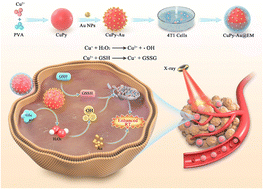A tumor cell exosome-mimicking multifunctional nanozyme for targeted breast cancer radiotherapy†
Abstract
Radiotherapy (RT) has been extensively used for the treatment of breast cancer. However, the efficacy of RT is reduced by the high content of reducing species within cells (such as glutathione (GSH)). In addition, high-dose radiotherapy is often accompanied by serious side effects. In an attempt to resolve these issues, a tumor cell exosome-mimicking multifunctional nanozyme system (CuPy-Au@EM) was developed as a radiosensitizer, which consists of an internal AuNP-embedded CuPy nanozyme core and an external tumor cell exosome membrane. The exosome membrane protein on the surface of CuPy-Au@EM leads to the accurate localization of nano-materials in the tumor site; simultaneously, the level of H2O2 will be enhanced because of the GOx-like activity of AuNPs. Then CuPy-Au@EM would continue to trigger a rapid decline in cellular GSH content and the production of a large number of hydroxyl radicals (˙OH) through its glutathione peroxidase (GPx) and peroxidase (POD) activities allows for the extension of the radiotherapeutic cascade. Studies conducted in vivo and in vitro demonstrated that the combination of CuPy-Au@EM and moderate dose RT (4 Gy) can significantly reduce tumor proliferation. These findings indicated that CuPy-Au@EM nanospheres could be plausibly developed into promising radio-sensitizers on tumors.

- This article is part of the themed collection: Nanozymes


 Please wait while we load your content...
Please wait while we load your content...